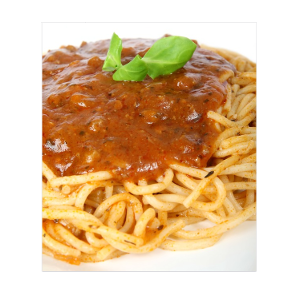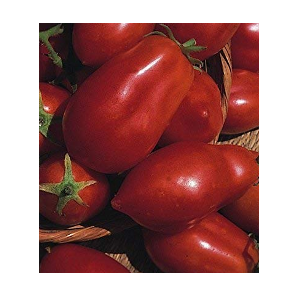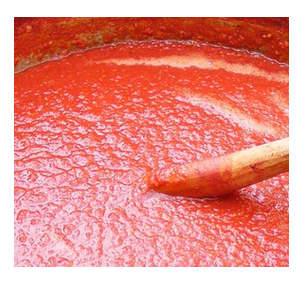Homemade Passata Recipe
Key ingredient in Italian recipes
Homemade Passata is a very easy to make, with a much better taste than the ones you buy in a shop (and a lot cheaper)
It is an essential ingredient in many italian recipes (such as pizzas, Bolognese sauce, lasagna, etc.)
Especially if you grow them at home it a great way to use up your surplus harvest tomatoes and use them throughout the year.

3 Key items to making Passata.
The recipe lower down the page will show you exactly how to make it.
But there are 3 key elements to making the best possible homemade Passata:
1. Make it simple
You might see lots of recipes for Passata with added basil, garlic, etc.
Those are not the real authentic Passata types, but a bit like a flavoured tomato sauce. A real Passata will only be made using 1 ingredient – tomatoes.
2. Use San Marzano Tomatoes
Linked to this the type of tomato you use will make a real difference – all depending on the size of the skin, water content, etc.
When making Passata you will notice that San Marzano tomatoes will provide you with the authentic, real flavour.

3. Use freshly picked Tomatoes
When you use freshly picked, ripe tomatoes you will notice a real difference in the flavour. This flavour will carry on into your homemade passata recipe – and it will simply taste so much better than any ready made passate you might buy in a shop.
Growing them at home is not very difficult – whether you want to grow them indoors (spare bedroom?) or outdoors. When you grow your own tomatoes using a hydroponic kit or aquaponic kit you will end up harvesting a lot of tomatoes.
To get the best results
To get the best possible passata, there are 3 items that I’ve found to be very important.
- As mentioned above the type of tomato used
- A food mill – to help you get the best possible sauce
- And of course the quality of the storage jars (And yes, they do make a difference)
I can’t stress enough the importance of the type of tomatoes you use. Either Roma or San Marzano tomatoes will add a real taste difference.
Unfortunately they are virtually impossible to buy fresh, but they are very easy to grow at home in your kitchen, spare bedroom, etc.
All you will need is a grow pot, maybe a light and of course seeds.
The homemade passata recipe
Making passata is quick & easy, but the difficulty is often in how to store it.
The recipe below will show you step by step how to make your own passata.
Ingredients
To make your own homemade passata you will need
- 1 kg (Or more) San Marzano tomatoes – yes you can use tomatoes from a shop but either San Marzano or Roma tomatoes will help you get the best flavour.
- 1 litre Cold water Tap water will do (for washing tomatoes)
Equipment
You won’t need much equipment – most of it is usually available in most kitchen at any stage.
To make the homemade passata
- You will need a Sauce pan, knife and sieve or strainer.
- But the one item that will make it a lot easier (as opposed to using a blender) is a Food mill (like the one shown right) – Available from Amazon
To store the homemade passata
You have 2 options (see below)
If you want to freeze your homemade passata you will need
- A funnel
- And freezer bags

Or if you want to store your homemade passata in jars you will need
- A Funnel
- Re-sealable jars
- Baking tray
Instructions
To make the homemade Passata
Step 1 – prepare the tomatoes
- If you’ve grown your own tomatoes then select & pick the ripe ones
- The wash the tomatoes under a cold water tap
- Cut the tomatoes in half & half again if large.
Step 2 – prepare the tomatoes
- Place the tomatoes in a large saucepan with lid on
- Put in the oven at low heat for about 20 minutes until they are soft
- When the tomatoes have softend remove from oven and use a food mill or blender to extract the liquid.
- (You might need to run it through a sieve a couple of times, repeating the process with the material from the sieve)
- Heat in the saucepan on a low heat for about 10 to 20 minutes – until thick
Step 3 – store the homemade passata
You have 2 options:
Frozen or Room Temperature?
Personally I prefer to simply freeze the homemade passata, as it’s a much easier way for packing. On the other hand using jars does tend to free up a lot of space, and will let you keep your homemade passata a lot longer.
Option 1 – How to store Passata frozen
Let the Passata cool down. Then using a funnel pour small amount (usually about 500g) in a freezer bag to store frozen.
It’s important to use the Passata within 3 months
Option 2 – How to store Passata in Jars
This is a bit more difficult but the advantage is that you can store it at ambient temperature, in a dark cupboard.
To do this you will need resealable glass jars, which need to be sterilised.
All you do is preheat the oven to 160 to 180°C. At the same time wash the jars and lids in hot soapy water.
Then you rinse the jars but do not dry them. Put the jars on a baking tray and put in the oven for 10 minutes. At the same time soak the lids in boiling water for a few minutes. Then take the jars from the oven and let cool on a kitchen towel

Using the funnel fill each jar, but not to the rim – leave about 1/2 inch from the top – and put on the lid. Put a dish towel in a large pot and put the jars on top. (That’s to stop the danger of them getting damaged).Fill the pot with water, so that the jars are covered, and bring to the boil.
Boil the jars for 40 minutes and then remove the jars and let cool down. If the lids are indented then the seal is perfect, if not use that jar within 14 days.
Update on the homemade passata recipe 31/10/2020
Please note I have slightly changed the recipe. Having grown a very large amount of roma tomatoes at home (using the indoor hydroponic system) I decided to try a few different recipe methods.
Simply heating the tomatoes in the oven was very simple and easy to do. However do keep an eye on them as you don’t want them to get to soft – but the taste when made is great and ideal for Ragu or Bolognese sauce. Hopefully the above has helped, please find below the updated recipe:
.
Homemade Passata Recipe
Equipment
- Sauce pan
- Chef Knife
- Sieve or strainer
Ingredients
- 1 kg Roma Tomatoes or San Marzano Tomatoes (or more)
- 1 litre Water (Tap water will do) – used for washing tomatoes
Instructions
- Wash the tomatoes under a cold water tap
- Cut the tomatoes in half or quarters (if large)
- Place in a large saucepan with lid on
- Put in the oven or on the hob at low heat for about 20 minutes, until the tomatoes are soft
- When the tomatoes are soft remove from heat and use a food mill or blender to extract the liquid.
- (You might need to run it through a sieve a couple of times, repeating the process with the material from the sieve)
- Either store it in the freezer or resealable jars
Video
Notes
Nutrition
Made this recipe ?
Would be great if you could click on a star above right (below the main picture) to rate it
More information
Hopefully the homemade passata recipe might inspire you to grow your own fresh tomatoes at home.
To grow your own tomatoes
It’s not very difficult to grow your own at home – even indoors (in your kitchen, spare bedroom, garage, etc. All you will need are seeds, growing system and some growing lights. There is detailed description of the – indoor tomato growing system
The equipment needed
To make the homemade passata is not very difficult, and you will probably already have most of the equipment. The one item I find that made a real difference is the rotatory food mill – Available from Amazon
How you store it is very personal – yes jars probably makes sense, but frozen is a lot easier.


Plain tomatoes are not safe in a water bath canner. Without added acid they could develop botulism. Please suggest freezing or using a pressure canner.
I agree, prefer to freeze it (which is also a lot easier)
You are correct. Must be heated according to directions in a pressure canner, to ensure no botulism poisoning. Simple tomatoes do not have the acidity to prevent botulism or other organisms growing in the product.